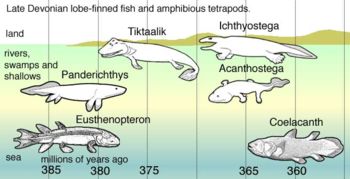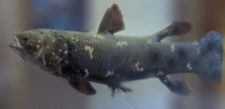Sarcopterygii
Fossil range: Latest
Silurian - Recent |

Coelacanth, Latimeria chalumnae
|
|
Scientific classification |
|
|
| Subclasses |
Coelacanthimorpha - Coelacanths
Dipnoi - Lungfishes
Tetrapodomorpha - Tetrapods
|
Sarcopterygii (from Greek sarx, flesh, and
pteryx, fin) is traditionally the
class of lobe-finned
fishes, consisting of
lungfish and
coelacanths. These are bony fish with paired rounded fins.
These fins, being similar to limbs, suggest that these fish
may be ancestors of land vertebrates.
Most taxonomists who subscribe to the
cladistic approach include within this group the superclass
Tetrapoda, which in turns consists of all species of
four-limbed vertebrates. The fin-limbs of sarcopterygiians show such
a strong similarity to the expected ancestral form of
tetrapod limbs that they have been universally considered
the direct ancestors of tetrapods in the scientific
literature.
Taxonomy and Phylogeny
- Class SARCOPTERYGII
- Subclass
Coelacanthimorpha
-
Rhipidistia
- Subclass
Dipnoi
- Order Ceratodontiformes
Order Lepidosireniformes
- Subclass
Tetrapodomorpha
- Order
Rhizodontida
- Superorder
Osteolepidida
- Family
Tristichopteridae
- Order
Osteolepiformes
- Order
Panderichthyida
-
Tiktaalik
-
Tetrapoda

In
Late Devonian vertebrate speciation, descendants
of pelagic lobe-finned fish – like
Eusthenopteron – exhibited a sequence of
adaptations:
-
Panderichthys, suited to muddy
shallows;
-
Tiktaalik with limb-like fins that
could take it onto land;
-
Early tetrapods in weed-filled swamps,
such as:
-
Acanthostega which had feet with
eight digits,
-
Ichthyostega with limbs.
Descendants also included pelagic lobe-finned
fish such as
coelacanth species.
Evolution of Sarcopterygii
Sarcopterygians belong to Osteichthyes group or bony
fishes, characterized by their bony skeleton instead of
cartilage. The oldest Sarcopterygians were found in the
Uppermost Silurian. The first Sarcopterygian closely
resembled Acanthodians. The Sarcopterygians closest
relatives were the Actinopterygians - ray-finned fishes.
Sarcopterygians probably evolved in the oceans, but they
later came into freshwater habitats to avoid the predatory
placoderms - which were dominant in the Early - Middle
Devonian seas. As Sarcopterygians evolve in the Early
Devonian, the line splits into two main lineages - the
Coelacanths, and the Rhipidistians. The Coelacanths appeared
in the Early Devonian, and stayed in the oceans, the
coelacanths heyday was the Late Devonian and Carboniferous
because they were more common at these times than any other
period in the Phanerozoic. Coelacanths still live today in
the oceans. Rhipidistians appeared about the same time as
the Coelacanths, but unlike them, Rhipidistians left the
ocean world and migrated into the freshwater habitats, their
ancestors probably lived in the oceans near the river mouths
(estuaries). The Rhipidistians in turn split into two major
groups - the lungfishes, and the tetrapodomorphs. The
lungfishes' greatest diversity was in the Triassic Period,
but today, there are less than a dozen genera left. The
lungfishes evolved the first proto-lungs and proto-limbs.
The lungfishes, ancient and modern, used their stubby fins
(proto-limbs) to walk in land if their waterhole is
depleted, and used their lungs to breathe air and get
sufficient oxygen. The tetrapodomorphs have the same
identical anatomy as the lungfishes, who were their closest
kin, but the tetrapodomorphs appear to have stayed in water
a little longer until the Late Devonian. Tetrapods - four
legged vertebrates were the terapodomorphs descendants.
Tetrapods appeared in the Late Devonian epoch.

Coelacanths are the only sarcopterygians that
live in the ocean
See also




